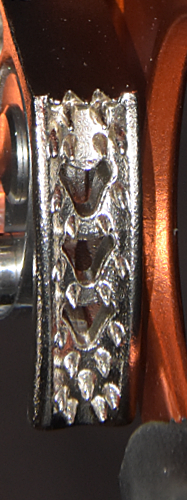Technical Details
 I acquired my Climbing Technology Quick’Arbor from Jim Goodall Equipment in 2014. I acquired another in 2017 as part of Bob Thrun’s collection.
I acquired my Climbing Technology Quick’Arbor from Jim Goodall Equipment in 2014. I acquired another in 2017 as part of Bob Thrun’s collection.
The Quick’Arbor is 222 mm. tall, 161 mm. wide, 57 mm. thick, and weighs 498 g.
The Quick’Arbor consists of two modified Climbing Technology Quick’Up ascenders bolted to a stamped plate. The Quick’Up ascenders are similar to the earlier version that I described above, so I'll use that description in gray and note the changes in black, as follows:
The shell is a tall irregular shaped stamping made from 3.9 mm. aluminum alloy sheet metal. A rope channel is formed in the
upper portion of one side and a smaller cam channel lies opposite
the first. The rope channel is 16 mm. wide. A hole drilled through both sides of the cam channel
accepts a 6 mm. rivet. The cam and cam spring are mounted on this
rivet, along with a plastic rope retainer. The rope retainer pivots on the cam axle. In the down position, a molded protrusion engages the oval hole through the rope channel, helping to hold the retainer closed. The retainer pivots upward to allow rigging. The handle
below the cam has a soft "rubbery" two-piece hand grip
riveted into place. The hand grip has four shallow finger grooves.
A 15.0 mm. sling attachment hole is punched below the handle opening,
and a 9.9 mm. hole is punched below and outside the first. A 15.9
by 18.9 mm. pear-shaped hole through both sides of the rope channel provide
an attachment point just above the cam. There is a stamped cam stop that almost stops the cam from closing far enough for the cam to hit the inside of the rope channel.
This ascender uses a standard
Climbing Technology cam found on many of their handled and handleless eccentric cam ascenders.
The cam is a plated skeletonized steel casting. The cam radius,
measured from the pivot, increases from 38 to 57 mm. over
an angle of 40°, giving a 31° cam angle. The cam has number
of small conical teeth, all of which have their axes approximately
parallel to the lower surface of the cam. The tooth pattern is
(3.2.4)(1H1.2)^3(3.2), where the "H" stands for a 4 mm. wide, 6 mm.
wide inverted subtriangular hole.
A spring-loaded manual safety
is mounted on an axle riveted to the center of the cam.
The normal action of the spring holds the safety against the cam.
When the cam is opened, the shell interferes with
the safety tab, thus preventing opening the cam. If the safety
is moved away from the cam (opposing the spring), the tab will
clear the shell and the cam will open. At full open the safety
can be released and the spring will hold the arm against the back of the shell, locking the cam
open.
A knurled pin on the safety assists in operating
the safety mechanism.
The two ascenders are riveted to a stamped connecting plate that holds the ascenders about 100° from each other. The plate has three cutouts. The upper two suggest an up-pointing arrow, while the lower one is a 19.2 mm. wide, 20.2 mm. high attachment hole.
The front of the ascender is printed with the CT logo, an image of a handless footless person cut in half, "max 100 kg," and "Patented." The lower portion of the connecting plate is printed with another image of a handless footless person cut in half, "max 100 kg," and an "A" inside a circle. The rear of the right ascender is printed with the Climbing Technology logo, "climbing technology," "QUICK’ARBOR," and "Patented." The rear of the left ascender is printed with "0034 - 91 - 14," "CE 0333," "EN 12841:2006-B," "Made in Italy," a book-with-an-"i" icon, and "0713." The front of each hand grip has "QUICK’UP" and the CT logo molded. The rear have "QUICK’UP right" and "left QUICK’UP," respectively.
|
 |
Warning:
The weight limit ("Max 100kg") printed on the handle can easily be
less than the weight of a fully loaded caver. |
 |
|
They are well-made ascenders. Most of the comments made on the Amelia ascender (clearly an earlier version of the current Quick’Up) apply to the Quick’Arbor as well.
The connecting plate holds the ascenders at an angle. Some people will find that this makes the Quick’Arbor more comfortable than other dual handle ascenders such as the Jumar Tree, Kong Trender, Kong Twin, or Petzl Ascentree but I find that it encourages leaning back, reducing climbing efficiency.
The rope retainer is the most interesting feature of this ascender. While it will not keep the rope from coming out in all situations, it will perform that function reasonably well in many. It is a nice safety feature, but don't bet your life on any gadget. The retainer latches well into the top carabiner hole. A carabiner will not fit in the hole if the the retainer is closed, but once one puts a carabiner in the hole, the carabiner performs the retainer’s function.
The weight limit ("max 100kg") printed on the rear of each ascender can easily be less than the weight of a fully loaded caver. Although I know what this means, American courts may not, so I cannot recommend this ascender for heavier cavers or for expedition caving. A similar comment applies to heavier arborists.


